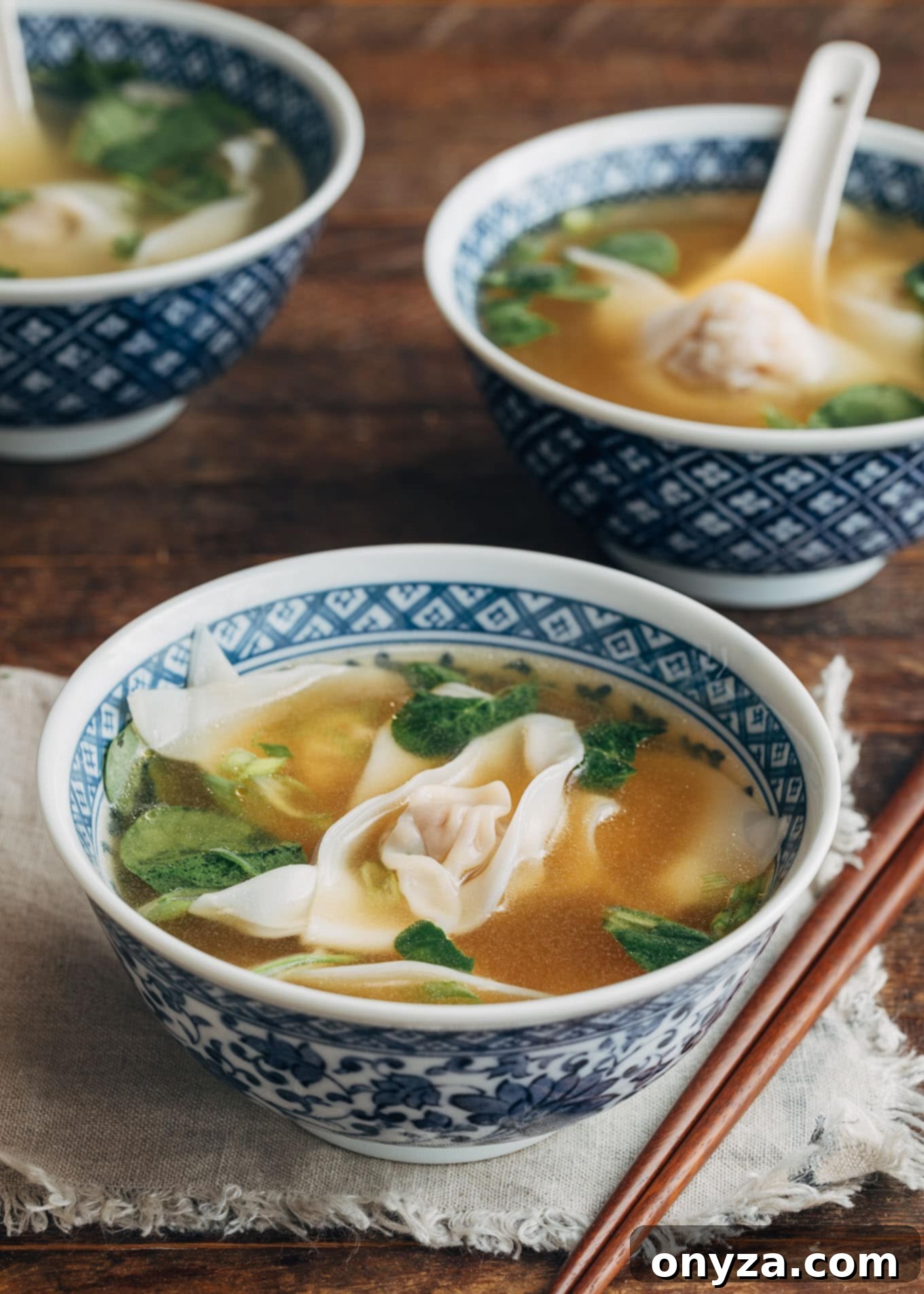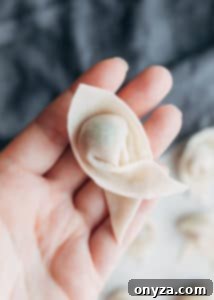Mastering Homemade Wonton Soup: A Comprehensive Guide to Authentic Flavors
There’s nothing quite like a steaming bowl of wonton soup to bring warmth and comfort, especially on a chilly evening. For many, it’s a staple of takeout menus, a dish that evokes a sense of cozy nostalgia and simple pleasure. The perfect wonton soup features an aromatic, flavorful broth, silky smooth wrappers, and a tender, savory filling that delights with every spoonful. This comprehensive guide will empower you to create a restaurant-quality pork and shrimp wonton soup right in your own kitchen. Forget the takeout menu; get ready to impress your family and friends with a homemade version that’s truly unforgettable.

Wonton soup holds a special place in my heart, much like many other Asian noodle and broth-based soups. It’s more than just a meal; it’s an experience that transports me back to childhood, gathered around the table with loved ones on a relaxed Friday night. The exquisite combination of a fragrant broth, delicate wonton skins, and succulent filling is pure comfort in a bowl. While it might seem intimidating, making takeout-inspired wonton soup at home is a rewarding culinary adventure, perfect for a weekend project where everyone can lend a hand. Follow along as we walk through each step, from preparing the rich filling to crafting the perfect broth, ensuring your homemade wonton soup is a resounding success.

Crafting the Perfect Wonton Filling: Pork and Shrimp Harmony
The heart of any exceptional wonton lies in its filling. To achieve that coveted restaurant-style texture and flavor, a classic blend of ground pork and finely minced shrimp is essential. This combination not only offers a fantastic taste but also contributes to a wonderfully tender and juicy interior that cooks beautifully within the wonton wrapper.
When selecting your ground pork, it’s crucial to opt for a cut with a decent fat content. Very lean pork, such as tenderloin, tends to result in a drier, tougher cooked filling, which is not what we want for these delicate dumplings. Look for ground pork that shows some marbling. Many local Asian markets offer excellent quality ground pork, often comparable to what you might grind yourself. Alternatively, don’t hesitate to ask the butcher at your local grocery store to freshly grind pork for you. For optimal flavor and texture, pork butt (also known as Boston butt) is highly recommended for its ideal fat-to-meat ratio.
For the raw shrimp, any size will do, as they will be finely processed. Instead of using a grinder, I prefer to mince them thoroughly with a sharp chef’s knife, aiming for an almost paste-like consistency. The goal is to create tiny pieces that seamlessly integrate with the ground pork, ensuring a uniform and refined texture in your filling. This meticulous mincing prevents large, chunky shrimp bits that could disrupt the wonton’s delicate structure and overall mouthfeel.

The seasonings for this pork and shrimp wonton filling are classic Chinese-inspired aromatics, designed to build layers of exquisite flavor. You’ll need freshly grated ginger, minced garlic, finely sliced scallions, a splash of Shaoxing rice wine, a dash of toasted sesame oil, light soy sauce, and a pinch of ground white pepper. These ingredients are foundational in Chinese cuisine and contribute significantly to the authentic taste of the wontons. For those eager to delve deeper into these essential ingredients and their uses, along with helpful shopping tips, consider exploring a dedicated guide to Chinese-inspired cooking pantry essentials.
After thoroughly mixing all the filling ingredients, there’s one small but highly recommended extra step: cook a small teaspoonful of the mixture in a skillet on the stove until fully cooked. This simple taste test allows you to assess the seasoning and make any necessary adjustments to the raw mixture before you commit to folding all the wontons. It’s a culinary safety net that ensures your wontons are perfectly seasoned to your personal preference every time.
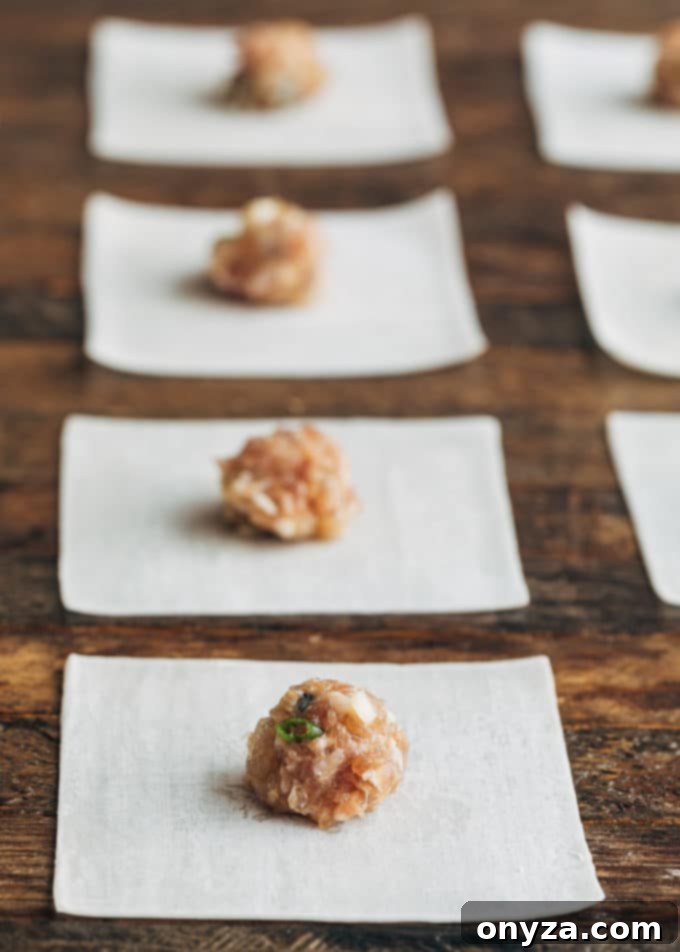
Selecting and Folding Wonton Wrappers for Soup
The wrapper is just as important as the filling in a good wonton soup. Choosing the right wrappers and mastering a simple folding technique will elevate your homemade soup to new heights.
Choosing the Right Wonton Wrappers
For this recipe, you’ll need to purchase square wonton wrappers, often labeled as “wonton skins,” which are distinct from the round wrappers typically used for potstickers. These are readily available at most regular grocery stores or, for a wider selection and often fresher options, at an Asian specialty market. I personally prefer the white, eggless “Shanghai style” skins for their delicate texture, but the slightly yellow-hued egg wrappers are also a popular choice and work just as well if that’s what you prefer or can find. A visit to an Asian market is highly recommended if you’re aiming for truly authentic, restaurant-quality dumplings, as they often boast an impressive variety of fresh wrappers.
Since these wontons will be simmered in broth, I recommend using wrappers that are thin to medium in thickness. Thicker wrappers tend to be more suitable for pan-frying, as they can become a bit chewy when boiled. The goal for wonton soup is a tender, almost melt-in-your-mouth wrapper that delicately encases the savory filling. Should you find yourself with leftover wonton wrappers, don’t let them go to waste! They can be easily transformed into delicious fried wonton strips for a quick snack or soup garnish.
Mastering Wonton Folding Techniques
The world of wonton folding offers a delightful array of techniques, from the beautifully simple triangle fold to more elaborate and decorative methods. Feel free to experiment with different folds to discover which one you enjoy most and which best suits your aesthetic preferences. The beauty of homemade wontons is in their unique, handcrafted charm.
My preferred method for wonton soup is the “Chao Shou,” or “folding hands,” technique. It’s a relatively straightforward fold that yields a visually appealing wonton, both before and after cooking. I’ve broken down this technique into step-by-step visuals below to guide you through the process.
Full disclosure: folding all the wontons is typically the most time-consuming part of this recipe. However, practice makes perfect, and you’ll likely find your speed and technique improving as you go. Plan to dedicate a bit of time to this step. Better yet, turn it into a fun group activity! Invite friends or family to join in; folding wontons together can be a wonderfully social and enjoyable experience. For more inspiration and detailed instructions on various folding styles, many online resources offer comprehensive guides, such as “10 Ways to Fold Wontons.”
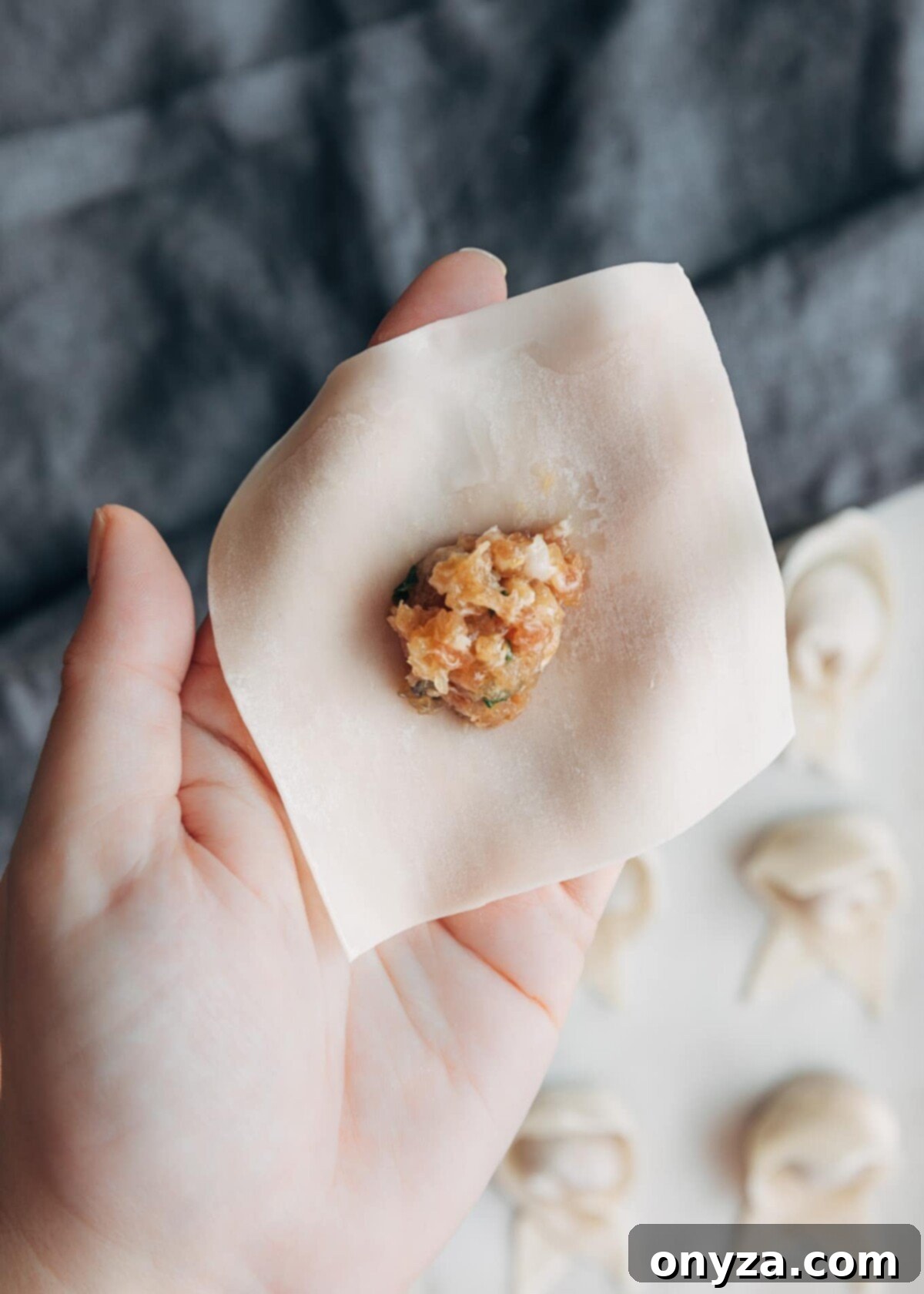
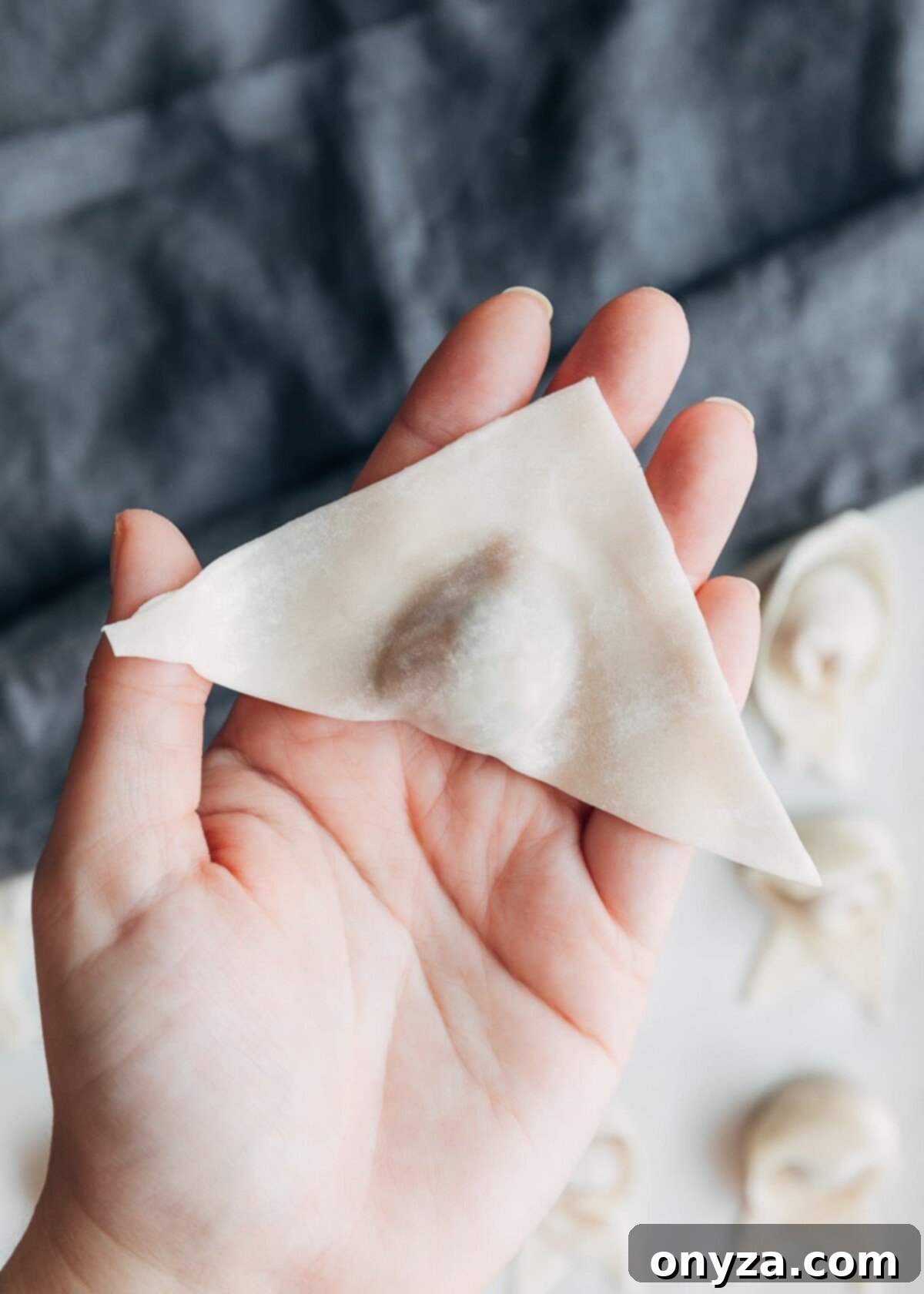
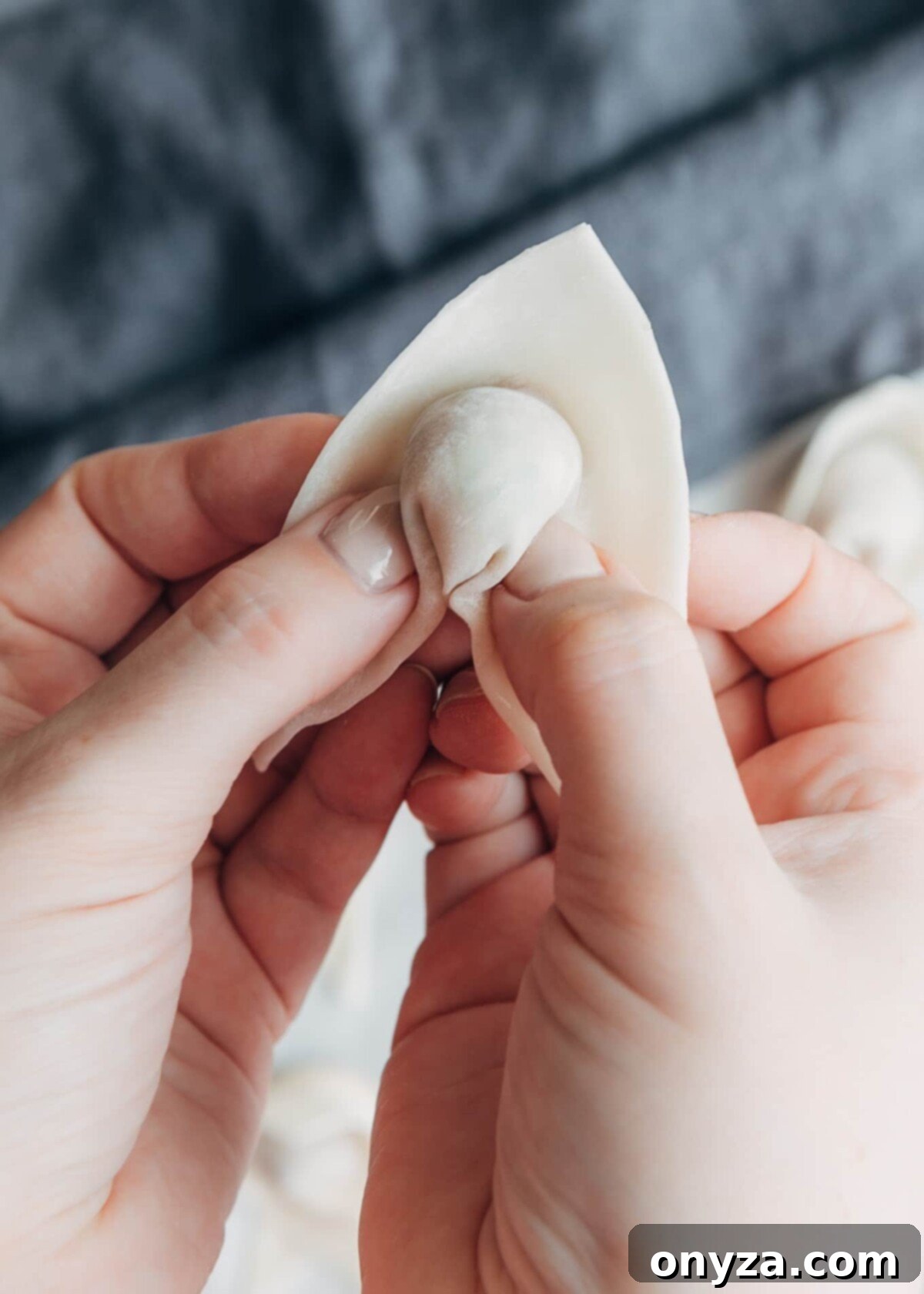
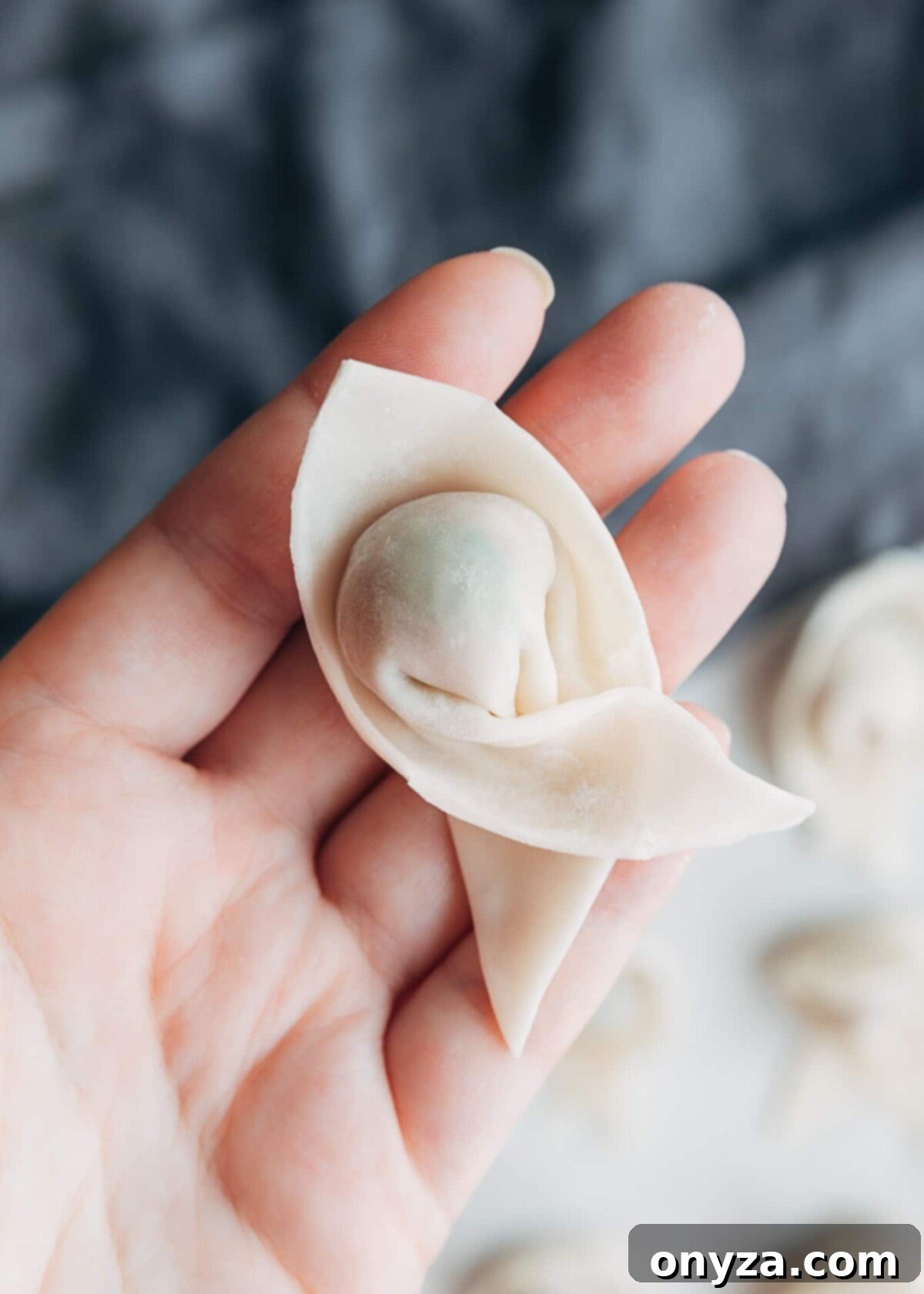
Essential Wonton Folding Tips for Success
- Prevent Drying Out: Wonton wrappers dry out remarkably quickly when exposed to air, becoming brittle and difficult to work with. Always keep both your stack of unused wrappers and your already-folded wontons covered with a lightly dampened towel as you work. I find it most efficient to work in small batches, typically filling and folding four wrappers at a time.
- Avoid Overfilling: Resist the temptation to stuff your wontons. Approximately one teaspoon of filling per wrapper is the ideal amount. Overfilled wontons are not only harder to seal but are also significantly more prone to splitting open during simmering, releasing their delicious filling into your broth.
- Expel Air Thoroughly: When making your initial fold over the filling, use your thumbs to gently but firmly press out as much air as possible from around the filling. You’ll likely feel small air pockets as you press. Trapped air pockets can cause the wontons to puff up excessively and split during cooking.
- Perfection Isn’t Required: Don’t stress if your folds aren’t absolutely perfect. Intricate folds, especially, can take some practice to master. What’s far more important than a perfectly symmetrical fold is ensuring that your wontons are well-sealed. A good seal prevents the filling from escaping into the broth, maintaining both the integrity of the wonton and the clarity of your soup.
- Prevent Sticking: As you finish folding each wonton, place them on a nonstick baking mat (like a Silpat) or a baking sheet lined with parchment paper that has been lightly dusted with cornstarch. This crucial step prevents them from sticking to the surface or to each other, which can lead to tearing when you try to pick them up for cooking.
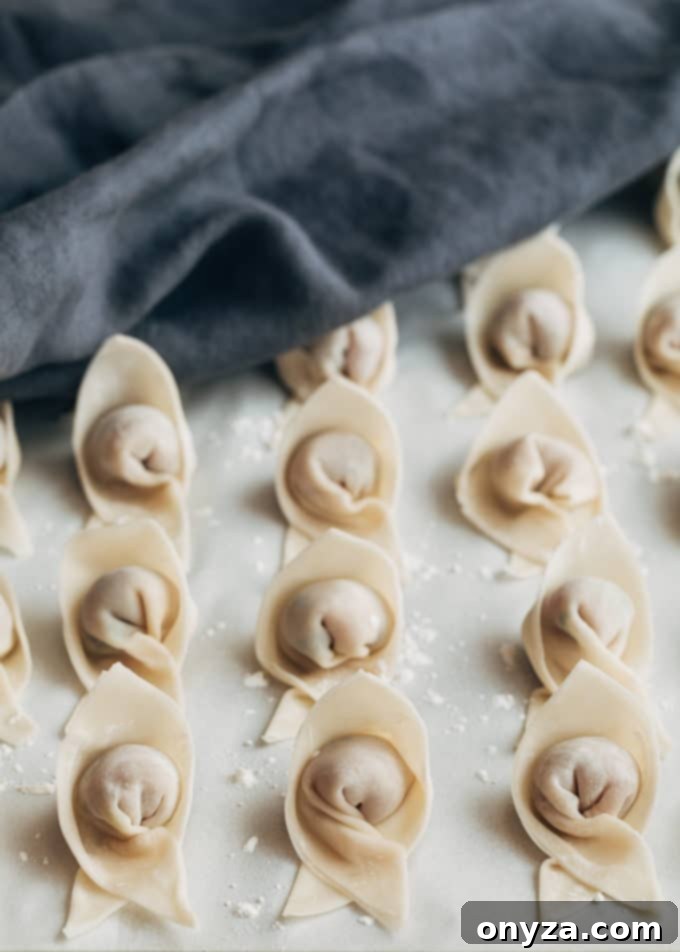
Cooking Your Wontons to Perfection
The final step before enjoying your wontons is cooking them properly. Wonton wrappers are typically dusted with starch (usually cornstarch) in their packaging to prevent them from sticking together. If you cook them directly in your soup broth, this starch can make the broth cloudy and slightly thick. To maintain a clear, vibrant broth, I highly recommend cooking the wontons separately in a pot of boiling water.
It’s best to simmer wontons in batches, ensuring they have enough room to float freely without crowding. The exact number you can cook at once will depend on the width of your pot. They cook quite quickly, typically needing only about 2 to 3 minutes until done. You’ll know they’re ready when they float to the surface of the water, and their wrappers appear transparent and slightly puckered around the filling. For food safety, the internal temperature of the filling should reach 160 degrees F (71 degrees C).
Freezing Homemade Wontons for Later Enjoyment
This recipe yields a generous batch of wontons, which is fantastic because they freeze beautifully, allowing you to enjoy homemade wonton soup whenever a craving strikes! To freeze them, arrange the freshly folded wontons in a single layer on the parchment-lined baking sheet you used earlier. Cover the sheet tightly with plastic wrap and place it in the freezer until the wontons are completely firm, usually a few hours. Once frozen solid, transfer them to a zip-top freezer bag, removing as much air as possible, and store them for up to three months. When you’re ready to cook them, there’s no need to defrost; simply drop the frozen wontons directly into boiling water and simmer for 3-5 minutes, or until cooked through.
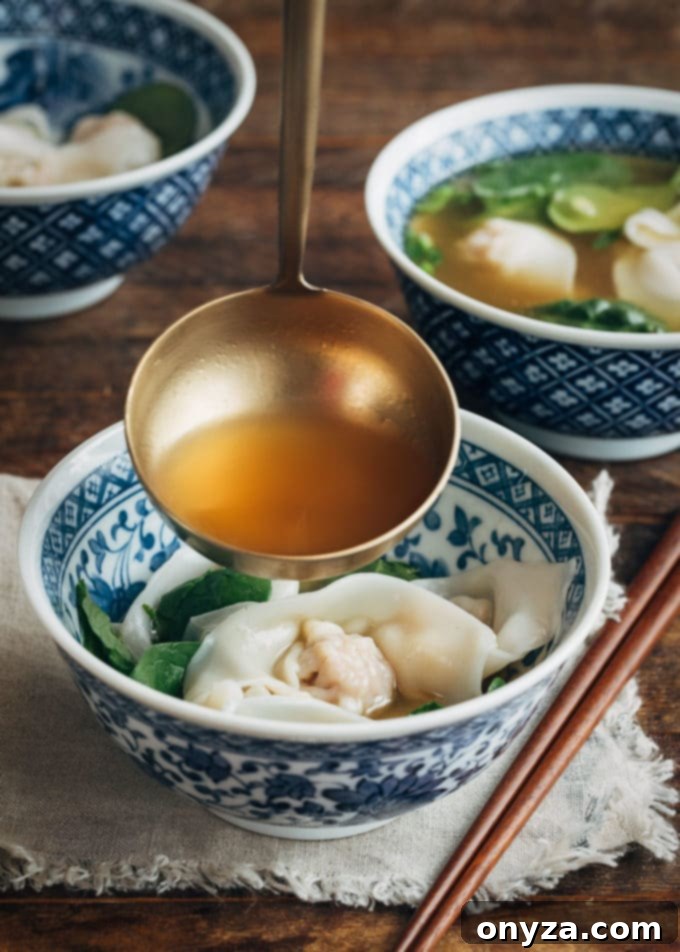
Crafting an Aromatic Infused Broth for Wonton Soup
While delicious homemade wontons can certainly be served with your favorite plain chicken broth or stock, elevating your soup to a true restaurant-style experience is incredibly simple with an infused broth. This process transforms ordinary store-bought (or homemade) chicken broth into a deeply aromatic and flavorful foundation for your wontons, perfectly complementing their savory filling.
All it takes is simmering your chicken broth for about 15 minutes with a few key additions. Incorporate the same wonderful aromatics and seasonings you used in the wonton filling—ginger, garlic, scallions, Shaoxing rice wine, and a touch of sesame oil and soy sauce. These flavors will gently steep into the broth, creating a rich, fragrant liquid that beautifully enhances the wontons and brings the entire dish together. After simmering, strain out the solids to achieve a clear, elegant broth, then season it to taste with salt and white pepper.
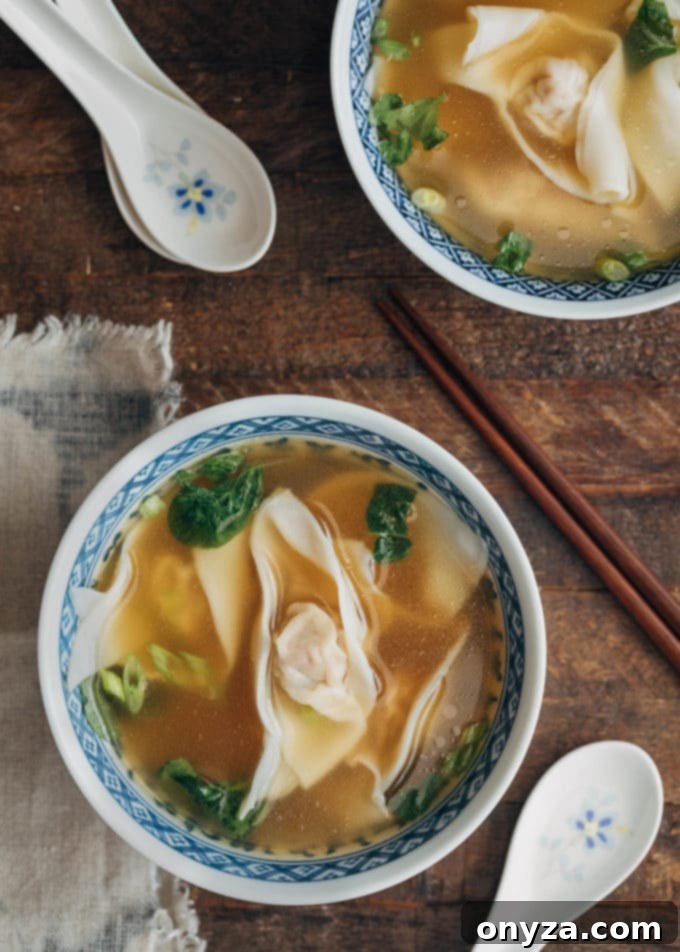
Serving Your Delicious Homemade Wonton Soup
Once your wontons are cooked and your broth is perfectly infused, it’s time to assemble and serve this comforting masterpiece. To serve, gently place the hot, cooked wontons into individual soup bowls. For a fresh and vibrant touch, you can add a few torn baby spinach leaves to each bowl. This addition is entirely optional; some excellent wonton soup restaurants include it, while others opt to leave it out. It adds a subtle earthy flavor and a pop of color, wilting beautifully in the hot broth.
Next, carefully ladle the piping hot seasoned broth over the wontons and spinach. Let the soup stand for a minute or two to allow the heat of the broth to gently wilt the spinach leaves to a tender consistency. Finish each bowl with a sprinkle of freshly sliced scallions for an added layer of flavor and a beautiful garnish. Take a moment to appreciate your handiwork before you dive in. With every slurp, you’ll be convinced this bowl of aromatic, comforting wonton soup could have only come from your favorite restaurant, proving that authentic flavors are truly achievable right in your own kitchen.
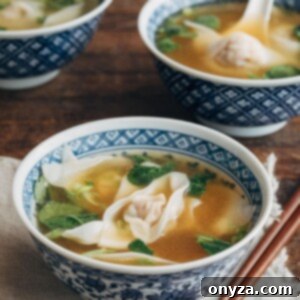
Wonton Soup Recipe
by Amanda Biddle
This classic pork and shrimp wonton soup is cozy, comforting, and absolutely delicious. For additional tips and tricks, including freezing instructions, please read through the blog post, above.
- Prep Time: 1 hour 30 minutes
- Cook Time: 20 minutes
- Total Time: 1 hour 50 minutes
- Servings: 8 to 10 servings
Ingredients
Wontons
- 6 ounces raw shrimp, peeled and deveined
- 6 ounces ground pork (with some fat to it)
- 1 large garlic clove, minced
- 1 teaspoon finely minced or grated ginger (I use a microplane)
- 2 tablespoons thinly-sliced scallions
- 1 tablespoon light soy sauce
- 2 teaspoons Shaoxing rice wine
- 1 teaspoon toasted sesame oil
- ½ teaspoon granulated sugar
- ¼ teaspoon kosher salt
- ⅛ teaspoon ground white pepper
- 48 wonton skins
Infused Broth
- 8 cups chicken broth
- 4 large scallions, halved
- 1 inch piece ginger, cut into slices*
- 2 cloves garlic, crushed
- 2 teaspoons Shaoxing rice wine
- ½ teaspoon sesame oil
- 2 tablespoons light soy sauce
- kosher salt and ground white pepper
To serve
- 1 cup baby spinach leaves, torn
- Sliced scallions for garnish
Instructions
Make the Wontons
- Finely mince raw shrimp until they are almost the consistency of a paste. Mix shrimp in a large bowl with ground pork, garlic, ginger, scallions, soy sauce, Shaoxing rice wine, sesame oil, sugar, salt, and pepper. Combine using a fork or mixing chopsticks until the filling is fairly smooth and paste-like.
- Cook about a teaspoon of filling in a skillet on the stove until cooked through. Taste the cooked filling for seasonings and adjust salt and pepper in the raw mixture accordingly.
To Fill and Fold
- Working 4 at a time, place a teaspoonful of filling onto the center of each wonton wrapper. (As you’re working, keep the stack of wonton wrappers and the wontons you’ve folded covered with a damp towel so they don’t dry out.)

- Use your finger or a pastry brush to dampen the top and right edges of the wrapper with water. Fold the bottom left corner over the filling to meet the top right corner, forming a triangle. Press around the filling to remove any trapped air from the folded wonton.

- Use your thumbs to gently cinch the wrapper around the filling at the bottom of the wrapper. This will pull the left and right “arms” of the triangle downward.

- Dampen the right arm with water and pass it under the left arm, gently pressing in the middle to seal.

Make the Broth
- In a large pot, combine chicken broth, scallions, ginger, garlic, rice wine, sesame oil, and soy sauce. Bring to a boil, reduce heat, and simmer for 15 minutes. Strain and discard solids. Season to taste with salt and white pepper.
Simmer the Wontons
- Bring a large pot of water to a boil. Add the wontons to the pot in batches, gently stirring so they don’t stick to the bottom, and being sure not to crowd them (they need to have enough room to float; I usually cook about 10 at a time).
- Simmer for 2-3 minutes, until the wrappers are transparent and the wontons float in the water. The internal temperature of the filling should be 160 degrees F.
To Serve
- Place wontons in soup bowls with a few torn baby spinach leaves, if desired. Ladle hot broth over the wontons. Let stand for 2-3 minutes so the spinach leaves wilt. Garnish with sliced scallions and serve.
Notes
*Sliced ginger infuses the broth with a bit of heat. If you prefer a very mild broth, omit the ginger, or decrease the quantity.
Nutrition Estimate
Calories: 240kcal | Carbohydrates: 29g | Protein: 14g | Fat: 6g | Saturated Fat: 2g | Cholesterol: 72mg | Sodium: 1749mg | Potassium: 372mg | Fiber: 1g | Vitamin A: 495IU | Vitamin C: 21.4mg | Calcium: 83mg | Iron: 3.1mg
Nutrition information is automatically calculated, so should only be used as an approximation.
About our recipes
Please note that our recipes have been developed using the US Customary measurement system and have not been tested for high altitude/elevation cooking and baking.
